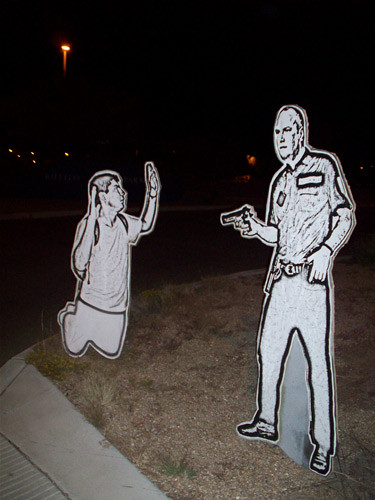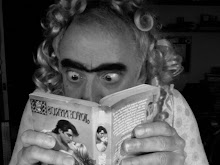|
|
Thursday, November 20th, 2008
I've been listening to Dylan's Modern Times a lot over the last couple of days, and having some reactions that seem like I could put them together into an article or essay. For now I'll just list some of what I'm thinking about, off the top of my head. - I like the record. It's nowhere near Dylan's best stuff; but it's a pleasure to listen to and to move with.
- One of the things I really love in Dylan's music is the way he creates a persona in his songs. I think here his focus wavers and sometimes the lyrics will not ring true, not go with the persona. One thing that occurred to me is that maybe here Dylan is not singing in a character, just being himself.
- The songs are long and do not always hold my attention. That's not necessarily bad -- when my attention wanders the song is happening in the background, then I come back and slip back into the song.
- The songs fall roughly into three groups, two that I like and one not: (A) "Spirit on the Water", "When the Deal Goes Down", "Ain't Talkin", and "Beyond the Horizon"; (B) "Thunder on the Mountain", "Rollin' and Tumblin'", "Someday Baby", "The Levee's Gonna Break"; (C) "Workingman's Blues #2" (which I'm maybe just putting in a group by itself so I can not like it.) "Nettie Moore" I'm reserving judgement on. Group (A) is more melodic, Group (B) is hard rocking, driving beat, often with a blues structure. (B) is generally more exciting; I really love "Beyond the Horizon" though, it might be the most moving song on the record.
- I really like hearing Dylan with a band behind him, and it's especially nice to hear the violin and cello. The band's sound might have been what prompted me to compare it to Basement Tapes, I think the comparison was mostly spurious.
posted evening of November 20th, 2008: Respond
➳ More posts about Modern Times
|  |
Monday, November 17th, 2008
 Matt Madden's book Exercises in Style arrived today and is proving to be just as much fun as I was expecting it would be. (i.e., A lot.) Funniest cartoon so far is "Dynamic Constraint", a takeoff on the Dynamic Tension ads in the back of every comic book of my childhood, starring Ray Queneau as Charles Atlas. That made me laugh helplessly for about five minutes. Matt Madden's book Exercises in Style arrived today and is proving to be just as much fun as I was expecting it would be. (i.e., A lot.) Funniest cartoon so far is "Dynamic Constraint", a takeoff on the Dynamic Tension ads in the back of every comic book of my childhood, starring Ray Queneau as Charles Atlas. That made me laugh helplessly for about five minutes.
posted evening of November 17th, 2008: Respond
➳ More posts about Readings
|  |
|
Janis lent me a copy of Dylan's recent disk, Modern Times. The first thing that hits me listening to it is what a huge range of variation there is in Dylan's work.  I mean listening to this you recognize instantly who is the author -- his voice and his personality are unmistakable -- but it's a brand-new sound, not quite like anything he's done in the last 40+ years. (That I can think of anyway. I don't have an encyclopædic familiarity with his work, but I do know a lot of it. The closest thing to this that I can think of, is Basement Tapes; but that's not at all a perfect match.) I mean listening to this you recognize instantly who is the author -- his voice and his personality are unmistakable -- but it's a brand-new sound, not quite like anything he's done in the last 40+ years. (That I can think of anyway. I don't have an encyclopædic familiarity with his work, but I do know a lot of it. The closest thing to this that I can think of, is Basement Tapes; but that's not at all a perfect match.) It's a groovy sound, too, different though it is from any of the Dylans I know and love. It's going to take a bunch more listening to really get to know the songs -- on first listen it seems like the real highlights of the record are "Rollin' and Tumblin'" and "The Levee's Gonna Break"; the only song I really didn't like was "Workingman's Blues #2" -- it seemed plodding and lifeless. A couple of the other songs were not perfect lyrically -- the quality of inspiration that you feel in Dylan's best work was not always present -- but the instrumental power carried them. I'm looking forward to keeping this on my car stereo for the next while and listening to it every day until I really get to know the songs. Also interested in finding out more about the source tunes these are based on; the only one I really know is Muddy Waters' "Rollin' and Tumblin'."
posted evening of November 17th, 2008: Respond
➳ More posts about Music
|  |
|
 Sylvia asked the question tonight that has been bugging me since we started reading The Golden Compass: "How do people get their dæmons when they are born?" I have no answer -- I said well, do you think the dæmons are born with the people, and she was like maybe... Sylvia asked the question tonight that has been bugging me since we started reading The Golden Compass: "How do people get their dæmons when they are born?" I have no answer -- I said well, do you think the dæmons are born with the people, and she was like maybe...
posted evening of November 17th, 2008: Respond
➳ More posts about His Dark Materials
|  |
|
 The complete works of H.P. Lovecraft are now readable at dagonbytes.com. Cause for good cheer among the paranoid. I loved his stories as a child, have not read them in a long time though. (via Doug in comments at Is there no sin in it?) The complete works of H.P. Lovecraft are now readable at dagonbytes.com. Cause for good cheer among the paranoid. I loved his stories as a child, have not read them in a long time though. (via Doug in comments at Is there no sin in it?)
posted afternoon of November 17th, 2008: Respond
|  |
|
Sr. Saramago é 86 anos.

posted morning of November 17th, 2008: Respond
➳ More posts about José Saramago
|  |
Saturday, November 15th, 2008
Last night's dream was taking place on a lot of different levels of narrative resolution, and I woke up remembering several of them. Unfortunately all that melted away very quickly -- the only bit of it I remember is this, which I believe was the enclosing story: I'm at my friend Michael's funeral. (It's just occurring to me now that maybe this was childhood friend Michael Lopes -- while the dream was happening I was only thinking of the friend as "Michael".) The proceedings were not exactly what I expect a funeral to be like; sort of a cross between reader's theater and a role-playing game. The mood was more levity than mourning. Near the end I sought out Michael's mother and asked her why they had set it up this way; her response was, "Because otherwise we would have to speak of him as if he were our son; and we can't do that." (Or possibly "and we are forbidden to do that.")
posted morning of November 15th, 2008: Respond
➳ More posts about Dreams
|  |
Friday, November 14th, 2008
 via the Wooster Collective, I've been looking at a couple of graphics in the last few days that put me in mind of Saramago's Tuesday post about immigration. The sculpture shown to the right is Jens Galschiot's image of a homeless man, which will inaugurate his Welcome Homeless program, displaying statues of homeless people in European capitals. via the Wooster Collective, I've been looking at a couple of graphics in the last few days that put me in mind of Saramago's Tuesday post about immigration. The sculpture shown to the right is Jens Galschiot's image of a homeless man, which will inaugurate his Welcome Homeless program, displaying statues of homeless people in European capitals.
And in Tuscon, activists have been displaying cardboard cutout statues of the local right-wing sheriff and border patrol agent around town. This is pretty inspired.
posted evening of November 14th, 2008: Respond
➳ More posts about Pretty Pictures
|  |
|
The narrative style in Fortunata and Jacinta (at least, as it is filtered through this particular translator) is not exactly my preferred style. As I said before, it takes a lot of work to keep myself engaged with what's going on in the story -- in the works of fiction I really love, entering into the world of the book is an effortless thing. But that said, I think Pérez Galdós has a really exceptionally keen eye for human nature -- his observations of Juanito and Jacinta are resonating with me in a really close-to-home way. I've had a couple of moments recently of nodding my head in agreement and in surprise at the power of his depictions of their relationship. For instance, when Juanito was drunk on manzanilla and debasing himself before his new wife as a worthless cad for leaving Fortunata, I instinctively knew what was in his head -- I recognized times I've acted the same way and at the same time thought "Oh man, what an asshole he's being!" Now this is not a completely new thought -- I could have identified this behavior and its undesirability before reading this passage -- but I think Pérez Galdós' crystallization of this particular behavior pattern is striking and will stay with me. So nice from, I guess, a pædagogical angle.
posted afternoon of November 14th, 2008: Respond
➳ More posts about Fortunata and Jacinta
|  |
Wednesday, November 12th, 2008
Wow, this is unexpected and kind of exciting: Googling around for information about Benito Pérez Galdós reveals that Buñuel's Viridiana was (loosely) based on his novel Halma, and another of Buñuel's movies, Nazarín -- which I have not seen but sounds great -- is also based on a text by Pérez Galdós. Slant magazine describes Viridiana as "noticeably derivative of the similarly-themed Nazarín," which it calls "Buñuel's 1958 masterpiece." Not sure how much use this knowledge will be for me; Halma does not appear to be translated into English and I don't even know what the title of the source text for Nazarín is. Still: interesting.
 (Looks like the title of the source text for Nazarín is Nazarín -- Biblioteca Nueva published an edition of it and Halma bound together a few years back. No luck looking for translations though.) Update: Dr. Rhian Davies of the University of Sheffield has compiled a list of Pérez Galdós's works in translation. Jo Labanyi's translation of Nazarín was published in '96. No translation of Halma apparently. Dr. Davies also let me know that Buñuel's Tristana (1970) is an adaptation of Perez Galdós' work of the same title. Tristana appears in translation in Colin Partridge's book Tristana: Buñuel's Film and Galdós' Novel: A Case Study. I have pulled an essay that deals with Tristana in some detail from Google's cache.
posted afternoon of November 12th, 2008: Respond
➳ More posts about Viridiana
| Previous posts
Archives  | |
|
Drop me a line! or, sign my Guestbook.
•
Check out Ellen's writing at Patch.com.
| |








 I mean listening to this you recognize instantly who is the author -- his voice and his personality are unmistakable -- but it's a brand-new sound, not quite like anything he's done in the last 40+ years. (That I can think of anyway. I don't have an encyclopædic familiarity with his work, but I do know a lot of it. The closest thing to this that I can think of, is Basement Tapes; but that's not at all a perfect match.)
I mean listening to this you recognize instantly who is the author -- his voice and his personality are unmistakable -- but it's a brand-new sound, not quite like anything he's done in the last 40+ years. (That I can think of anyway. I don't have an encyclopædic familiarity with his work, but I do know a lot of it. The closest thing to this that I can think of, is Basement Tapes; but that's not at all a perfect match.)
 Sylvia asked the question tonight that has been bugging me since we started reading The Golden Compass: "How do people get their
Sylvia asked the question tonight that has been bugging me since we started reading The Golden Compass: "How do people get their 



 via the
via the 


 of The Great Whatsit
of The Great Whatsit  I just found
I just found 